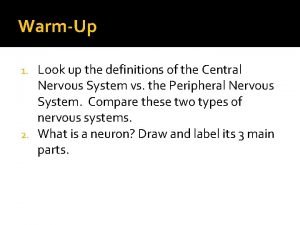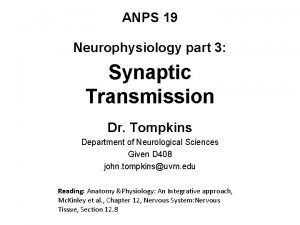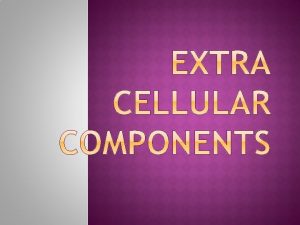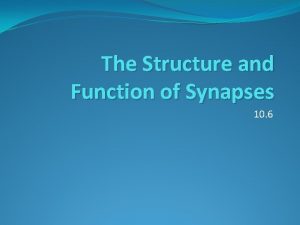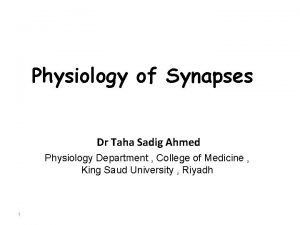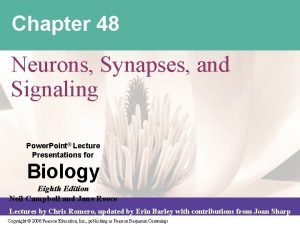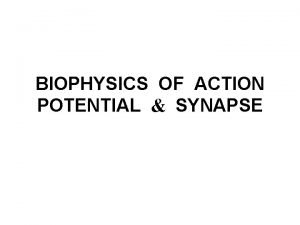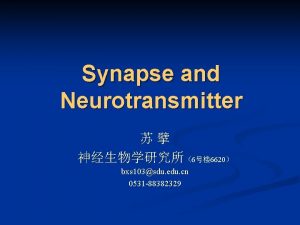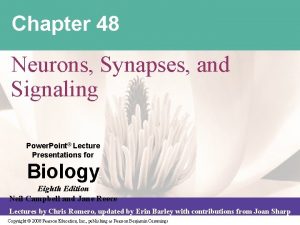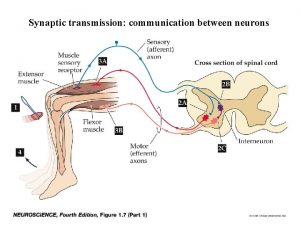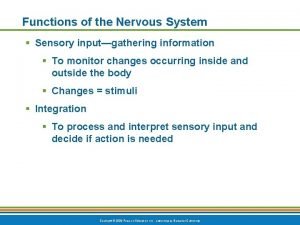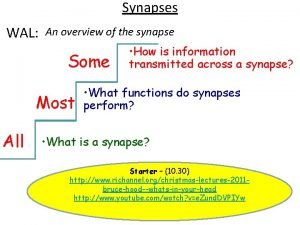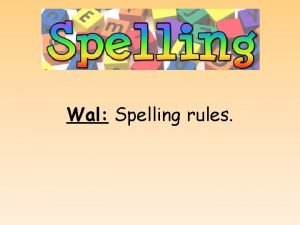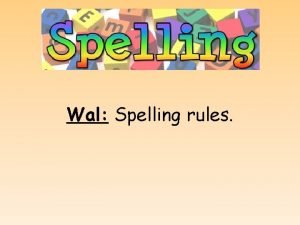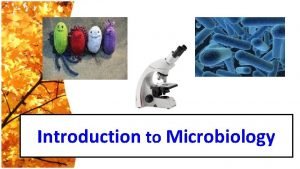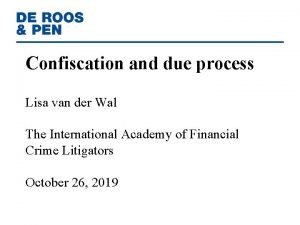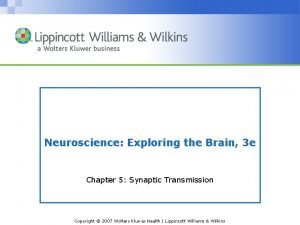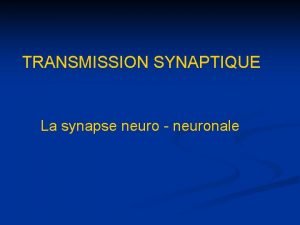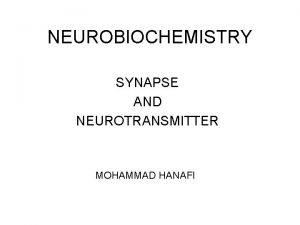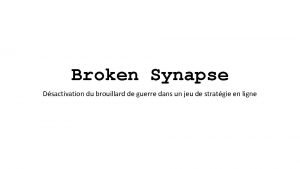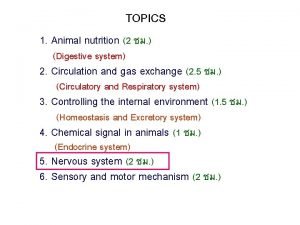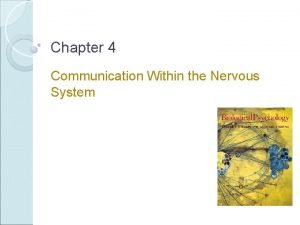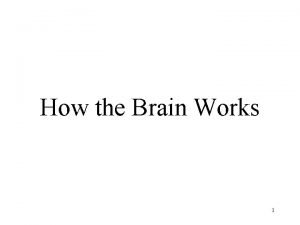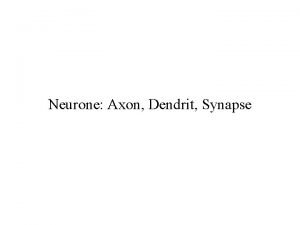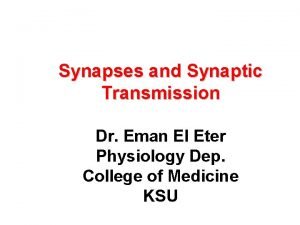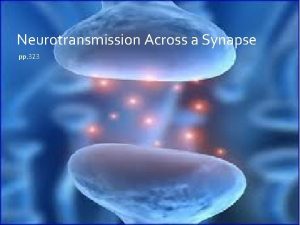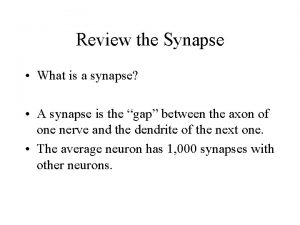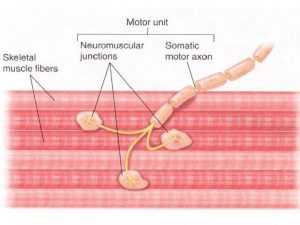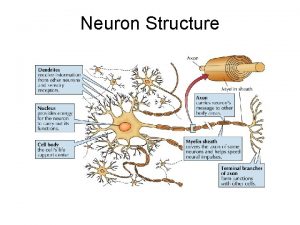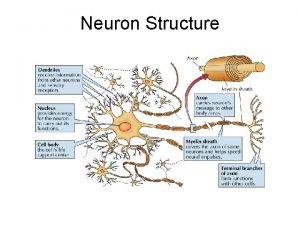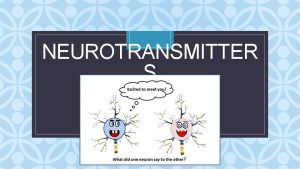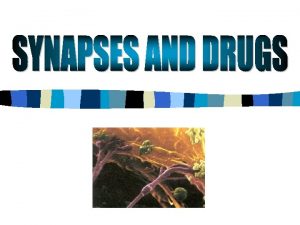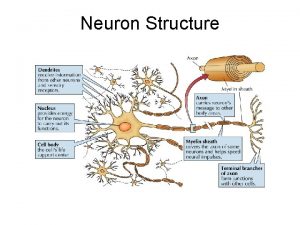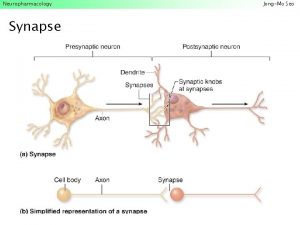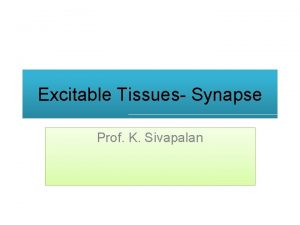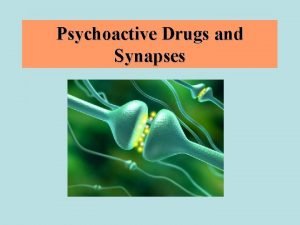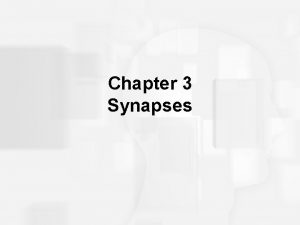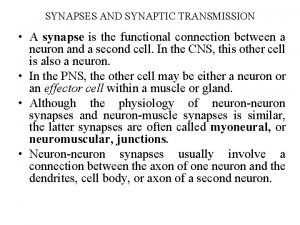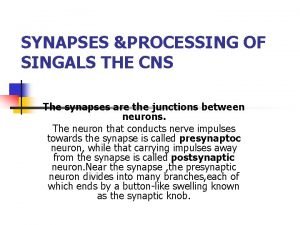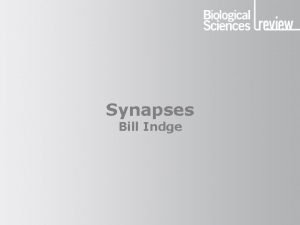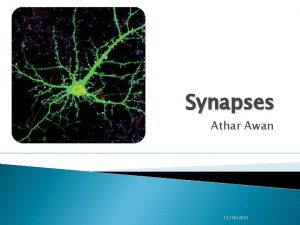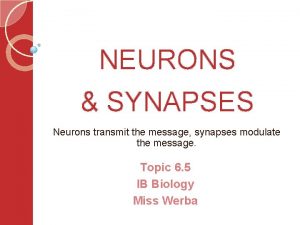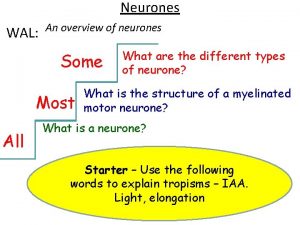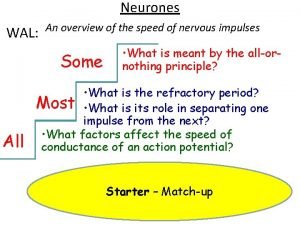Synapses WAL An overview of the synapse Some






































- Slides: 38

Synapses WAL: An overview of the synapse Some Most All • How is information transmitted across a synapse? • What functions do synapses perform? • What is a synapse? Starter – (10. 30) http: //www. richannel. org/christmas-lectures-2011 bruce-hood--whats-in-your-head http: //www. youtube. com/watch? v=e. Zund. DVPIYw

Today we are covering from the specification: Pages 174 -176 of your textbook

Synapses • Synapses are gaps between neurones • Information is sent between neurones by chemical transmission • Neurotransmitters pass across the synaptic cleft (a small gap 20 -30 nm wide between neurones) from the presynaptic neurone • A new action potential will be triggered in the post synaptic neurone

Functions of a synapse Synapses act as junctions between neurones allowing: • A single impulse to be transmitted to a number of different neurones creating simultaneous responses. • A number of impulses to be combined at a synapse allowing stimuli from different receptors to interact for a single response.

Understanding checkpoint! WAL: All An overview of synapses • What is a synapse? Explain to your partner the function of a synapse


Presynaptic Neurone Mitochondrion Synaptic Membrane Knob of postsynaptic Synaptic neurone Cleft Smooth Incoming Action. Endoplasmic Potential Reticulum Calcium ion channel Synaptic vesicle containing neurotransmitter Sodium ion channels Postsynaptic Neurone

Incoming Action Potential Neurotransmitter New action Potential


• The incoming action potential causes depolarisation in the synaptic knob • This causes calcium channels to open • Calcium ions (Ca 2+) flood into the synaptic knob

Incoming Action Potential Ca 2 +

• The influx of calcium ions causes synaptic vesicles to fuse with the presynaptic membrane • This releases neurotransmitter in to the cleft So calcium ions cause the release of neurotransmitter

Incoming Action Potential Ca 2 +

• Neurotransmitter (acetylcholine) is released into the synaptic cleft. • Acetylcholine binds to the receptor site on the sodium ion channels. • Sodium ion channels open

Ca 2 + Neurotransmitter (acetlycholine) is released into the synaptic cleft. Acetlycholine binds to the receptor site on the sodium ion

• The sodium channels on the postsynaptic membrane are normally closed. • When the neurotransmitter binds there is a conformational change opening the channel. • This allows sodium ions to flood in and causes depolarisation. Na+ Neurotransmitter binds and opens the channel.

Empty Synaptic Vesicles Sodium ions diffuse into the postsynaptic Depolarise

• Neurotransmitter (acetylcholine) is released into the synaptic cleft. • Acetylcholine binds to the receptor site on the sodium ion channels. • Sodium ion channels open • Sodium ions diffuse in (down steep concentration gradient) • Postsynaptic neurone depolarises

• Depolarisation inside the postsynaptic neurone must be above a threshold value • If the threshold is reached a new action potential is sent along the axon of the post synaptic neurone

Incoming Action Potential Neurotransmitter New action Potential

• When do the calcium channels open and close? • Why are the calcium ions important? • What is the name of the neurotransmitter? • Explain how the neurotransmitter causes a new action potential to be generated.

• • Step 1 Calcium channels open Step 2 Neurotransmitter release Step 3 Sodium Channels Step 4 New action potential • Step 5 Acetylcholinesterase • Step 6 Remaking acetylcholine

• A hydrolytic enzyme • Breaks up acetylcholine (the neurotransmitter) into acetyl (ethanoic acid) and choline.


• Acetylcholinesterase is an enzyme that hydrolyses acetylcholine in to separate acetyl (ethanoic acid) and choline. • Sodium ion channels close. • The two bits diffuse back across the cleft into the presynaptic neurone. • This allows the neurotransmitter to be recycled.

Depolarised Acetylcholine binds and opens Sodium channels Acetylcholinesterase breaks up acetylcholine. Sodium channels close

• If the neurotransmitter is not broken down this could allow it to continuously generate new action potentials • Breaking down acetylcholine prevents this

• Name the hydrolytic enzyme and the products of the reaction. • Why must the neurotransmitter be broken down? • What happens to the remnants of the neurotransmitter?

• ATP released by mitochondria is used to recombine acetyl (ethanoic acid) and choline thus recycling the acetylcholine. • This is stored in synaptic vesicles for future use. • More acetylcholine can be made at the SER. • Sodium ion channels close in the absence of acetylcholine at their receptor sites. • The synapse is now ready to be used again.

The Whole Process

Incoming Action Potential Ca 2 +



Features of a synapse Unidirectionality • Synapses can only travel in one direction: from the presynaptic neurone to the postsynaptic neurone (like valves)

Features of a synapse Summation Low frequency action potentials often produce insufficient amounts of neurotransmitter to trigger a new action potential in the postsynaptic neurone. They can, however, be made to do so in summation.

Spatial Summation Q. What is Temporal Summation?

Features of a synapse Spatial summation • A number of different presynaptic neurones together release enough neurotransmitter to exceed the threshold value of the postsynaptic neurone. Together they therefore trigger a new action potential Temporal summation • A single presynaptic neurone releases neurotransmitter many times over a short period. If the total amount exceeds the threshold value of the postsynaptic neurone, then a new action potential is triggered

Synapses WAL: An overview of the synapse Most All • What functions do synapses perform? • What is a synapse? Plenary– 1) Fill in A 3 mind-map 2) Refections: What did you learn? What do you want to find out? How might you find this out? What skills did you use?
 Summary illustration mouse party
Summary illustration mouse party Chemical synapses
Chemical synapses Distribution of gated channels on a neuron
Distribution of gated channels on a neuron Gap junctions vs plasmodesmata
Gap junctions vs plasmodesmata Functions of synapses
Functions of synapses Renshaw cells
Renshaw cells Chapter 48 neurons synapses and signaling
Chapter 48 neurons synapses and signaling Synapses telecom
Synapses telecom What are electrical synapses
What are electrical synapses 2 types of synapses
2 types of synapses Chapter 48 neurons synapses and signaling
Chapter 48 neurons synapses and signaling Chemical synapses
Chemical synapses How is one-way conduction at synapses ensured
How is one-way conduction at synapses ensured Synapse functions
Synapse functions Wal rules
Wal rules How do you spell wal
How do you spell wal Subhanallahi rauf
Subhanallahi rauf Was isra wal miraj a dream
Was isra wal miraj a dream Isra wal miraj map
Isra wal miraj map Sql 문제
Sql 문제 Al-ishlaahu
Al-ishlaahu Ist der wal ein fisch
Ist der wal ein fisch Cell wal
Cell wal Rumusan ahli sunnah wal jamaah
Rumusan ahli sunnah wal jamaah Wal dwuzębny
Wal dwuzębny Wallonie on map
Wallonie on map Allah quotes
Allah quotes Lisa van der wal
Lisa van der wal Synapse machine learning
Synapse machine learning Wolters kluwer health
Wolters kluwer health Synapse neuro neuronale
Synapse neuro neuronale Different types of synapse
Different types of synapse Inhibitory neurotransmitter
Inhibitory neurotransmitter Synapse decompiler
Synapse decompiler Integration center
Integration center Axoaxonic
Axoaxonic Synapse
Synapse Interneuronale synapse
Interneuronale synapse Temporal summation example
Temporal summation example
